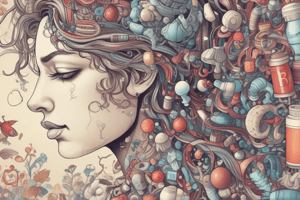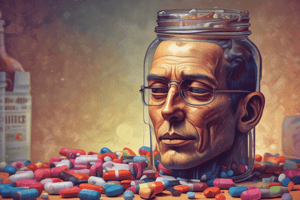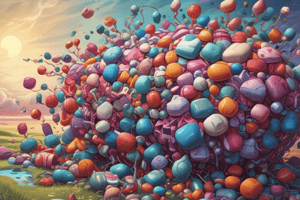Podcast
Questions and Answers
What happens to neurotransmitters after they are released into the synapse?
What happens to neurotransmitters after they are released into the synapse?
- They are destroyed immediately and have no further function.
- They remain bound to the receptor cells indefinitely.
- They are either reuptaken, metabolized by enzymes, or diffuse away. (correct)
- They are converted into hormones for systemic circulation.
Which neurotransmitter is synthesized from the amino acid tyrosine?
Which neurotransmitter is synthesized from the amino acid tyrosine?
- Norepinephrine
- Serotonin
- Epinephrine
- Dopamine (correct)
What is the primary location of norepinephrine in the nervous system?
What is the primary location of norepinephrine in the nervous system?
- Cerebrum
- Brain stem (correct)
- Spinal cord
- Cerebellum
Which function is primarily associated with the frontal lobes of the brain?
Which function is primarily associated with the frontal lobes of the brain?
How do antipsychotic medications primarily function?
How do antipsychotic medications primarily function?
Which lobe of the brain is primarily responsible for auditory processing?
Which lobe of the brain is primarily responsible for auditory processing?
Serotonin is primarily involved in which function?
Serotonin is primarily involved in which function?
What condition has been linked to abnormalities in dopamine transmission?
What condition has been linked to abnormalities in dopamine transmission?
What is the role of the corpus callosum in the brain?
What is the role of the corpus callosum in the brain?
Which neurotransmitter has been implicated in anxiety disorders due to excess levels?
Which neurotransmitter has been implicated in anxiety disorders due to excess levels?
What brain structure is primarily responsible for coordinating movements and maintaining posture?
What brain structure is primarily responsible for coordinating movements and maintaining posture?
What is the main effect of the fight-or-flight response controlled by epinephrine?
What is the main effect of the fight-or-flight response controlled by epinephrine?
Which amino acid is a precursor for serotonin synthesis?
Which amino acid is a precursor for serotonin synthesis?
Which part of the brain is involved in the control of complex movements?
Which part of the brain is involved in the control of complex movements?
What is the primary function of the frontal lobes in the brain?
What is the primary function of the frontal lobes in the brain?
What is the primary role of antidepressant drugs?
What is the primary role of antidepressant drugs?
Which part of the brain is primarily involved in coordinating movements and maintaining posture?
Which part of the brain is primarily involved in coordinating movements and maintaining posture?
What does the half-life of a drug refer to?
What does the half-life of a drug refer to?
What role does the hypothalamus play in the brain?
What role does the hypothalamus play in the brain?
Which neurotransmitter is primarily linked to smooth coordinated movements?
Which neurotransmitter is primarily linked to smooth coordinated movements?
Which neurotransmitter is most commonly involved in mood regulation?
Which neurotransmitter is most commonly involved in mood regulation?
What is akathisia characterized by?
What is akathisia characterized by?
Which neurotransmitter is associated with stress and anxiety?
Which neurotransmitter is associated with stress and anxiety?
In the context of psychopharmacology, what is a black box warning?
In the context of psychopharmacology, what is a black box warning?
Which of the following is a potential effect of dopamine in the brain?
Which of the following is a potential effect of dopamine in the brain?
Which brain structure regulates activity, sensation, and emotion?
Which brain structure regulates activity, sensation, and emotion?
What is a primary function associated with the temporal lobes?
What is a primary function associated with the temporal lobes?
What major risk does serotonin syndrome present?
What major risk does serotonin syndrome present?
What is the significance of the kindling process in neurological disorders?
What is the significance of the kindling process in neurological disorders?
Which lobe is primarily involved in language generation and visual perception?
Which lobe is primarily involved in language generation and visual perception?
What is a common barrier to maintaining a medication regimen for mental illness?
What is a common barrier to maintaining a medication regimen for mental illness?
Dystonia can be defined as:
Dystonia can be defined as:
What kind of drug is specifically used to treat anxiety disorders and insomnia?
What kind of drug is specifically used to treat anxiety disorders and insomnia?
Which category of drugs is used to treat mood disorders primarily by affecting serotonin levels?
Which category of drugs is used to treat mood disorders primarily by affecting serotonin levels?
Which of the following statements accurately describes tardive dyskinesia?
Which of the following statements accurately describes tardive dyskinesia?
What is one of the key nursing considerations when managing clients on psychopharmacological treatment?
What is one of the key nursing considerations when managing clients on psychopharmacological treatment?
Which type of nerve cells form networks and communicate through neurotransmission?
Which type of nerve cells form networks and communicate through neurotransmission?
Which imaging technique is most commonly used to visualize soft tissue structures?
Which imaging technique is most commonly used to visualize soft tissue structures?
What is the primary function of the reticular activating system?
What is the primary function of the reticular activating system?
What is a critical sign that indicates the effectiveness of treatment for clients with mental illness?
What is a critical sign that indicates the effectiveness of treatment for clients with mental illness?
Which structure is NOT typically included in the limbic system?
Which structure is NOT typically included in the limbic system?
Which of the following is a major barrier to maintaining a medication regimen?
Which of the following is a major barrier to maintaining a medication regimen?
What neurotransmitter is primarily synthesized from the amino acid tyrosine?
What neurotransmitter is primarily synthesized from the amino acid tyrosine?
Which function is primarily associated with serotonin?
Which function is primarily associated with serotonin?
How does the extrapyramidal system primarily function?
How does the extrapyramidal system primarily function?
What condition is NOT commonly associated with disturbances in the limbic system?
What condition is NOT commonly associated with disturbances in the limbic system?
Which of the following is a common side effect of anticholinergic medications?
Which of the following is a common side effect of anticholinergic medications?
Which mechanism describes how neurotransmitters can cease their action in the synapse?
Which mechanism describes how neurotransmitters can cease their action in the synapse?
What is the purpose of the black box warning on medication packages?
What is the purpose of the black box warning on medication packages?
What role does norepinephrine play in the nervous system?
What role does norepinephrine play in the nervous system?
What role does the limbic system play in relation to neurotransmitters?
What role does the limbic system play in relation to neurotransmitters?
What is primarily affected in individuals with excess norepinephrine?
What is primarily affected in individuals with excess norepinephrine?
Which neurotransmitter is involved in the regulation of mood and emotional responses?
Which neurotransmitter is involved in the regulation of mood and emotional responses?
What is the main characteristic of dopamine as a neurotransmitter?
What is the main characteristic of dopamine as a neurotransmitter?
What is akathisia primarily characterized by?
What is akathisia primarily characterized by?
What is the mechanism of action for stimulant drugs?
What is the mechanism of action for stimulant drugs?
Which neurotransmitter is involved in the fight-or-flight response?
Which neurotransmitter is involved in the fight-or-flight response?
Antidepressant drugs are primarily used to manage which of the following conditions?
Antidepressant drugs are primarily used to manage which of the following conditions?
Which of the following can indicate treatment effectiveness for psychopharmacologic therapy?
Which of the following can indicate treatment effectiveness for psychopharmacologic therapy?
What is a common barrier to maintaining a medication regimen?
What is a common barrier to maintaining a medication regimen?
What is one of the primary functions of the hypothalamus?
What is one of the primary functions of the hypothalamus?
What does the term 'black box warning' refer to?
What does the term 'black box warning' refer to?
Which is NOT a function of neurotransmitters?
Which is NOT a function of neurotransmitters?
What is serotonin syndrome, and what can it result from?
What is serotonin syndrome, and what can it result from?
Which neurologic side effect is characterized by shuffling gait and muscle stiffness?
Which neurologic side effect is characterized by shuffling gait and muscle stiffness?
What kind of drugs are mood-stabilizing medications mainly used for?
What kind of drugs are mood-stabilizing medications mainly used for?
What neurotransmitter has received significant attention in psychiatric disorder studies?
What neurotransmitter has received significant attention in psychiatric disorder studies?
What is a depot injection, and what is its purpose?
What is a depot injection, and what is its purpose?
Which neurotransmitter is primarily involved in the control of complex movements?
Which neurotransmitter is primarily involved in the control of complex movements?
What describes tardive dyskinesia?
What describes tardive dyskinesia?
What is neuroleptic malignant syndrome (NMS)?
What is neuroleptic malignant syndrome (NMS)?
What does 'half-life' refer to in pharmacology?
What does 'half-life' refer to in pharmacology?
Which type of medications are used to stabilize mood in bipolar disorder?
Which type of medications are used to stabilize mood in bipolar disorder?
What are extrapyramidal symptoms generally associated with?
What are extrapyramidal symptoms generally associated with?
What does the term 'pseudoparkinsonism' refer to?
What does the term 'pseudoparkinsonism' refer to?
Which diagnostic test primarily uses a magnet and radio waves?
Which diagnostic test primarily uses a magnet and radio waves?
What type of syndrome is characterized by agitation, fever, and confusion due to serotonin?
What type of syndrome is characterized by agitation, fever, and confusion due to serotonin?
Which term best describes drugs that excite the central nervous system?
Which term best describes drugs that excite the central nervous system?
What is the kindling process in relation to seizure activity?
What is the kindling process in relation to seizure activity?
What are anticholinergic side effects commonly associated with?
What are anticholinergic side effects commonly associated with?
What does the term 'off-label use' of a drug mean?
What does the term 'off-label use' of a drug mean?
What is the primary effect of dopamine in the brain?
What is the primary effect of dopamine in the brain?
What neurotransmitter is primarily associated with anxiety disorders due to its excess?
What neurotransmitter is primarily associated with anxiety disorders due to its excess?
Which imaging technique uses a radioactive tracer to monitor brain activity?
Which imaging technique uses a radioactive tracer to monitor brain activity?
What is the main limitation of using MRI compared to CT scans?
What is the main limitation of using MRI compared to CT scans?
What dietary amino acid is serotonin derived from?
What dietary amino acid is serotonin derived from?
Which neurotransmitter is primarily excitatory?
Which neurotransmitter is primarily excitatory?
Which imaging technique is noted for providing detailed structural images of the brain?
Which imaging technique is noted for providing detailed structural images of the brain?
What condition has been shown to correlate with enlarged ventricles in individuals with schizophrenia?
What condition has been shown to correlate with enlarged ventricles in individuals with schizophrenia?
Which of the following disorders has been linked with dopamine dysfunction?
Which of the following disorders has been linked with dopamine dysfunction?
In which brain imaging technique is a person required to remain motionless for about 20 to 40 minutes?
In which brain imaging technique is a person required to remain motionless for about 20 to 40 minutes?
What is the primary purpose of antipsychotic medications regarding dopamine?
What is the primary purpose of antipsychotic medications regarding dopamine?
What effect does excess serotonin have on the body?
What effect does excess serotonin have on the body?
Which imaging technique provides functional information about the brain rather than structural?
Which imaging technique provides functional information about the brain rather than structural?
What can be inferred if a patient shows decreased cerebral blood flow during imaging?
What can be inferred if a patient shows decreased cerebral blood flow during imaging?
What is the primary function of the corpus callosum?
What is the primary function of the corpus callosum?
Which lobe of the brain is associated with interpreting sensations of taste and touch?
Which lobe of the brain is associated with interpreting sensations of taste and touch?
Which of the following is NOT a function of the frontal lobe?
Which of the following is NOT a function of the frontal lobe?
Which brain structure is primarily responsible for regulating activity, sensation, and emotion?
Which brain structure is primarily responsible for regulating activity, sensation, and emotion?
What is the role of the cerebellum in motor control?
What is the role of the cerebellum in motor control?
Which of the following structures bridges the gap between the cerebrum and the medulla oblongata?
Which of the following structures bridges the gap between the cerebrum and the medulla oblongata?
Which neurotransmitter has been implicated in the lack of smooth coordinated movements in diseases such as Parkinson's disease and dementia?
Which neurotransmitter has been implicated in the lack of smooth coordinated movements in diseases such as Parkinson's disease and dementia?
Which of the following is involved in emotional arousal and memory?
Which of the following is involved in emotional arousal and memory?
What is the function of neurotransmitters in the nervous system?
What is the function of neurotransmitters in the nervous system?
What is the term for the gap between two neurons where neurotransmitters are released?
What is the term for the gap between two neurons where neurotransmitters are released?
Which of the following is NOT a factor that can terminate the action of a neurotransmitter?
Which of the following is NOT a factor that can terminate the action of a neurotransmitter?
Which brain structure is associated with stress, anxiety, and impulsive behavior?
Which brain structure is associated with stress, anxiety, and impulsive behavior?
Which neurotransmitter is primarily involved in regulating mood, sleep, and appetite?
Which neurotransmitter is primarily involved in regulating mood, sleep, and appetite?
Which part of the brain stem is involved in vital centers for respiration and cardiovascular functions?
Which part of the brain stem is involved in vital centers for respiration and cardiovascular functions?
Which of the following is NOT a lobe of the cerebral cortex?
Which of the following is NOT a lobe of the cerebral cortex?
Which of the following is NOT a function of the temporal lobes?
Which of the following is NOT a function of the temporal lobes?
Flashcards
Akathisia
Akathisia
Intense need to move; characterized by restlessness and pacing.
Anticholinergic Side Effects
Anticholinergic Side Effects
Symptoms like dry mouth and constipation from medications.
Antidepressant Drugs
Antidepressant Drugs
Medications for major depression and anxiety disorders.
Antipsychotic Drugs
Antipsychotic Drugs
Signup and view all the flashcards
Anxiolytic Drugs
Anxiolytic Drugs
Signup and view all the flashcards
Black Box Warning
Black Box Warning
Signup and view all the flashcards
Computed Tomography (CT)
Computed Tomography (CT)
Signup and view all the flashcards
Dopamine
Dopamine
Signup and view all the flashcards
Extrapyramidal Symptoms (EPSs)
Extrapyramidal Symptoms (EPSs)
Signup and view all the flashcards
Half-Life
Half-Life
Signup and view all the flashcards
Limbic System
Limbic System
Signup and view all the flashcards
Serotonin Syndrome
Serotonin Syndrome
Signup and view all the flashcards
Stimulant Drugs
Stimulant Drugs
Signup and view all the flashcards
Tardive Dyskinesia (TD)
Tardive Dyskinesia (TD)
Signup and view all the flashcards
Withdrawal
Withdrawal
Signup and view all the flashcards
Neuroleptic Malignant Syndrome (NMS)
Neuroleptic Malignant Syndrome (NMS)
Signup and view all the flashcards
Epinephrine
Epinephrine
Signup and view all the flashcards
Serotonin
Serotonin
Signup and view all the flashcards
Potency
Potency
Signup and view all the flashcards
Neurotransmitters
Neurotransmitters
Signup and view all the flashcards
Reuptake
Reuptake
Signup and view all the flashcards
Enzymatic Degradation
Enzymatic Degradation
Signup and view all the flashcards
Norepinephrine
Norepinephrine
Signup and view all the flashcards
Cerebrum
Cerebrum
Signup and view all the flashcards
Frontal Lobes
Frontal Lobes
Signup and view all the flashcards
Parietal Lobes
Parietal Lobes
Signup and view all the flashcards
Temporal Lobes
Temporal Lobes
Signup and view all the flashcards
Occipital Lobes
Occipital Lobes
Signup and view all the flashcards
Cerebellum
Cerebellum
Signup and view all the flashcards
Brain Stem
Brain Stem
Signup and view all the flashcards
Monoamine Oxidase (MAO)
Monoamine Oxidase (MAO)
Signup and view all the flashcards
Dystonia
Dystonia
Signup and view all the flashcards
Midbrain
Midbrain
Signup and view all the flashcards
Reticular Activating System
Reticular Activating System
Signup and view all the flashcards
Extrapyramidal System
Extrapyramidal System
Signup and view all the flashcards
Locus Coeruleus
Locus Coeruleus
Signup and view all the flashcards
Thalamus
Thalamus
Signup and view all the flashcards
Hypothalamus
Hypothalamus
Signup and view all the flashcards
Hippocampus
Hippocampus
Signup and view all the flashcards
Neurotransmission
Neurotransmission
Signup and view all the flashcards
Central Nervous System
Central Nervous System
Signup and view all the flashcards
CNS
CNS
Signup and view all the flashcards
Medulla Oblongata
Medulla Oblongata
Signup and view all the flashcards
Pons
Pons
Signup and view all the flashcards
Pineal Body
Pineal Body
Signup and view all the flashcards
Corpus Callosum
Corpus Callosum
Signup and view all the flashcards
Left Hemisphere
Left Hemisphere
Signup and view all the flashcards
Right Hemisphere
Right Hemisphere
Signup and view all the flashcards
Excitatory Neurotransmitters
Excitatory Neurotransmitters
Signup and view all the flashcards
Inhibitory Neurotransmitters
Inhibitory Neurotransmitters
Signup and view all the flashcards
Dopamine's role in psychosis
Dopamine's role in psychosis
Signup and view all the flashcards
Epinephrine vs. Norepinephrine
Epinephrine vs. Norepinephrine
Signup and view all the flashcards
Effects of excess norepinephrine
Effects of excess norepinephrine
Signup and view all the flashcards
Dopamine synthesis
Dopamine synthesis
Signup and view all the flashcards
Antipsychotic action
Antipsychotic action
Signup and view all the flashcards
Neurotransmitter derived from tryptophan
Neurotransmitter derived from tryptophan
Signup and view all the flashcards
Function of serotonin
Function of serotonin
Signup and view all the flashcards
Effects of low serotonin
Effects of low serotonin
Signup and view all the flashcards
CT scanning
CT scanning
Signup and view all the flashcards
MRI advantages
MRI advantages
Signup and view all the flashcards
PET scans
PET scans
Signup and view all the flashcards
SPECT comparison
SPECT comparison
Signup and view all the flashcards
Cerebral blood flow in mental disorders
Cerebral blood flow in mental disorders
Signup and view all the flashcards
Norepinephrine reuptake inhibitors
Norepinephrine reuptake inhibitors
Signup and view all the flashcards
Study Notes
Neurobiological Theories and Psychopharmacology
- Key Terms:
- Akathisia: Intense need to move, characterized by restlessness, pacing, and an inner sense of unease.
- Anticholinergic Side Effects: Dry mouth, constipation, urinary issues (hesitancy/retention), dry nose, and blurred vision. Common medication side effect.
- Antidepressant Drugs: Treat major depressive disorder, anxiety, bipolar depression, and psychotic depression.
- Antipsychotic Drugs (Neuroleptics): Treat psychosis (delusions, hallucinations) in schizophrenia, schizoaffective disorder, and bipolar mania.
- Anxiolytic Drugs: Treat anxiety, anxiety disorders, insomnia, OCD, depression, PTSD, and alcohol withdrawal.
- Black Box Warning: Critical warning on medication packages about life-threatening side effects.
- Computed Tomography (CT): Diagnostic procedure using precise x-rays to take cross-sectional images (slices) of the brain.
- Depot Injection: Slow-release injectable antipsychotic for maintenance therapy.
- Dopamine: Neurotransmitter involved in movement, motivation, cognition, and emotions.
- Dystonia: EPS (extrapyramidal symptom) of antipsychotic meds; acute rigidity, difficulty swallowing, potential laryngospasm.
- Efficacy: Maximal therapeutic effect a drug can achieve.
- Epinephrine: Norepinephrine derivative, involved in attention, learning, memory, sleep, and mood.
- Extrapyramidal Symptoms (EPSs): Drug-related neurological side effects of antipsychotics (dystonia, pseudoparkinsonism, akathisia), treated with anticholinergics.
- Half-Life: Time for half the drug to be eliminated from the bloodstream.
- Kindling Process: Seizures escalating from minor to frequent/severe.
- Limbic System: Brain area above the brain stem, including thalamus, hypothalamus, hippocampus, and amygdala (though definitions vary).
- Magnetic Resonance Imaging (MRI): Diagnostic test visualizing soft tissues, using magnetic fields and radio waves.
- Mood Stabilizing Drugs: Treat bipolar disorder, stabilizing mood and preventing highs/lows.
- Neuroleptic Malignant Syndrome (NMS): Potentially fatal reaction to antipsychotics.
- Neurotransmitters: Chemical messengers in neurons, transmitting information throughout the body.
- Norepinephrine: Predominant neurotransmitter; involved in attention, learning, memory, sleep, and mood.
- Off-Label Use: Drug effective for a different condition than the original FDA approval.
- Positron Emission Tomography (PET): Diagnostic test evaluating brain function via radioactive substances.
- Postinjection Delirium/Sedation Syndrome: Cluster of symptoms after olanzapine injection.
- Potency: Amount of drug needed to reach maximum effect.
- Pseudoparkinsonism: EPS of antipsychotics; mimicking Parkinson's symptoms (shuffling gait, masklike face, rigidity).
- Psychoimmunology: Studies the effects of stress on the immune system.
- Psychopharmacology: Use of drugs to treat mental illness.
- Rebound: Temporary return of symptoms, potentially more intense than prior.
- Risk Evaluation and Mitigation Strategy (REMS): Actions/safeguards for use of potentially risky drugs requiring monitoring.
- Serotonin: Neurotransmitter involved in food intake, sleep, etc.
- Serotonin Syndrome: Potential life-threatening effects from combined serotonin-enhancing medications.
- Single-Photon Emission Computed Tomography (SPECT): Brain function test using radioactive substances.
- Stimulant Drugs: Drugs stimulating the central nervous system.
- Tardive Dyskinesia (TD): Late-onset, irreversible involuntary movements from antipsychotics.
- Withdrawal: New symptoms from discontinuing a substance/drug.
Brain Structures and Functions
- Central Nervous System (CNS): Brain, spinal cord, and nerves controlling voluntary actions. Consists of cerebrum, cerebellum, brainstem, and limbic system.
- Cerebrum: Divided into two hemispheres connected by the corpus callosum. Each hemisphere controls the opposite body side.
- Frontal Lobes: Thinking, movement, memories, emotions, and behavior.
- Parietal Lobes: Taste, touch, spatial orientation.
- Temporal Lobes: Smell, hearing, memory, emotions.
- Occipital Lobes: Visual interpretation, depth perception.
- Cerebellum: Movement and postural coordination.
- Brainstem: Midbrain, pons, medulla oblongata; controls vital functions (respiration, heart function). Includes pathways for motor information, reticular activating system influencing sleep/awareness, and extrapyramidal system relaying movement information. Contains the locus coeruleus, related to stress and anxiety.
- Limbic System: Contains thalamus (sensation, emotion), hypothalamus (temperature, appetite, endocrine function, sexual drive, anger/rage/excitement), hippocampus, and amygdala (emotional arousal, memory). Disturbances can be linked to certain mental illnesses.
Neurotransmitters
- Neurotransmission: Electrochemical communication between neurons.
- Neurotransmitters are chemical messages that fit into receptor sites on dendrites. Some are excitatory (trigger an action) and some are inhibitory (stop an action).
- Dopamine: Movement, motivation, cognition, emotions.
- Norepinephrine: Attention, learning, memory, sleep, mood.
- Epinephrine: Fight-or-flight response.
- Serotonin: Food intake, sleep.
Brain Imaging Techniques
- Computed Tomography (CT): Cross-sectional x-ray images, used to visualize brain tissue/structure. Useful for diagnosing tumors, assessing lesions, and identifying potential brain size changes, in disorders like schizophrenia.
- Magnetic Resonance Imaging (MRI): Visualizes brain structures using magnetic fields and radio waves; providing detailed info with more contrast than CT. Useful to assess brain structures.
- Positron Emission Tomography (PET): Examines brain function by monitoring radioactive substances' flow.
- Single-Photon Emission Computed Tomography (SPECT): Similar to PET but using different radioactive substances, providing functional imaging of blood flow and neuronal activity.
Studying That Suits You
Use AI to generate personalized quizzes and flashcards to suit your learning preferences.




